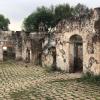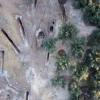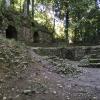Wari Foodways: A view from the Urban Core of Huari (AD 600-1000)
In January of 2019, the Stahl fund enabled me to travel to Ayacucho, Peru for analysis and collection of dissertation materials recovered from a domestic sector of the city of Huari (AD 600-1000). This trip allowed me to analyze charred botanical remains collected during excavation and artifacts recovered through flotation samples I processed through the 2017 and 2018 field seasons of the Huari Urban Prehistory Project co-directed through the University of Binghamton and the Universidad Nacional de San Cristobal de Huamanga.
Resilience and Foodways at La Chiripa, a Prehispanic Household in Arenal, Costa Rica
My research investigates the human-environmental interactions of Prehispanic peoples in the Arenal region of Costa Rica. This area is an ideal location to look at resilient practices in the past, since domestic settlements in Arenal persevered through powerful volcanic eruptions that impacted the landscape every few centuries.
Distributional (Siteless) Survey in the Environs of Kharaneh IV
A Revolution in Ruins: Historical Archaeology of Land Reform in Southwestern Queretaro, Mexico
In 2019, Stahl Foundation funding supported my dissertation fieldwork in southwestern Queretaro, Mexico. In Queretaro, research efforts largely focused on amassing a body of research materials associated with land reform. In particular, Stahl Foundation funding supported trips to manuscript depositories which resulted in the recovery of a significant amount of digital surrogates of archival material from local and state depositories.
Identification, Institutionalization, and Landscapes of Reuse at Tuberculosis Sanatorium Sites
The Historical Archaeology Sanatorium Project focuses on tuberculosis sanatoria in California during the early twentieth century. This project investigates issues related to disability, stigma, health, identity, and archaeologies of institutions in order to understand social aspects of health and disease. The Weimar Joint Counties Sanatorium was originally a government operated tuberculosis hospital for patients who were unable to pay for treatment elsewhere.
(Re)Performing Death in the Mycenaean World
My dissertation uses Performance Theory as a tool to examine the three major innovations to mortuary practices which take place at the beginning of the Mycenaean period: the creation of new tomb types, the use of these tombs for multiple burials, and the transition from intramural to extramural cemeteries. In particular, I use the work of performance theorists such as Schechner, Schneider, Austin, Butler, and Taylor, to explore how these developments altered the Mycenaeans’ experience of and relationship to death, as well as the wider cultural and social impacts of these innovations.
The Ziqpu-stars and Cuneiform Knowledge: Meaning, Applications, Contexts
In November 2019, I conducted research at the British Museum with the support of the Stahl Endowment of the Archaeological Research Facility. As part of my dissertation work, I examined, copied, photographed, and deciphered cuneiform tablets from the first millennium BCE Mesopotamia. My dissertation focuses on Babylonian astronomy and practices of telling time by the stars on one hand and producing astronomical knowledge on the other hand.
Communities of Practice in the Western Maya Lowlands
With Stahl funding, multi-sited collaborative research in the greater Palenque region in Chiapas, Mexico, continued. This grant supported the first season of excavations in a ritual structure at Palenque by Lisa Johnson.
Morphometric Analysis of Littleneck clams (Leukoma Staminea) from Tomales Bay
I harvested modern littleneck clams from Tomales Bay and developed several predictive formulae in order to assess harvesting profiles and changes in population size from fragmented clam remains represented in the archaeological record from Tomales Bay.















